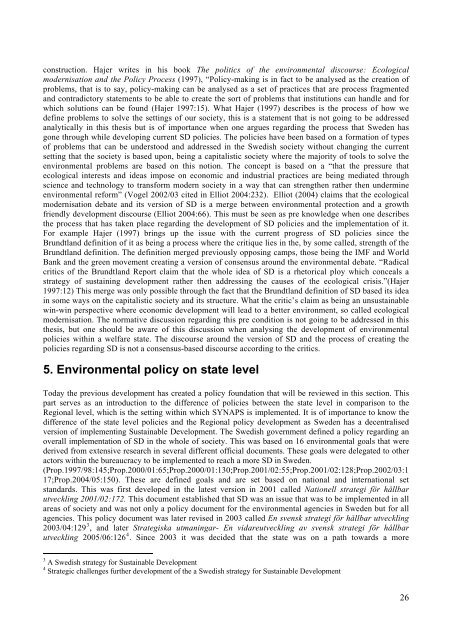From 'grey to green'- investigating the capabilities of the ... - lumes
From 'grey to green'- investigating the capabilities of the ... - lumes
From 'grey to green'- investigating the capabilities of the ... - lumes
Create successful ePaper yourself
Turn your PDF publications into a flip-book with our unique Google optimized e-Paper software.
construction. Hajer writes in his book The politics <strong>of</strong> <strong>the</strong> environmental discourse: Ecologicalmodernisation and <strong>the</strong> Policy Process (1997), “Policy-making is in fact <strong>to</strong> be analysed as <strong>the</strong> creation <strong>of</strong>problems, that is <strong>to</strong> say, policy-making can be analysed as a set <strong>of</strong> practices that are process fragmentedand contradic<strong>to</strong>ry statements <strong>to</strong> be able <strong>to</strong> create <strong>the</strong> sort <strong>of</strong> problems that institutions can handle and forwhich solutions can be found (Hajer 1997:15). What Hajer (1997) describes is <strong>the</strong> process <strong>of</strong> how wedefine problems <strong>to</strong> solve <strong>the</strong> settings <strong>of</strong> our society, this is a statement that is not going <strong>to</strong> be addressedanalytically in this <strong>the</strong>sis but is <strong>of</strong> importance when one argues regarding <strong>the</strong> process that Sweden hasgone through while developing current SD policies. The policies have been based on a formation <strong>of</strong> types<strong>of</strong> problems that can be unders<strong>to</strong>od and addressed in <strong>the</strong> Swedish society without changing <strong>the</strong> currentsetting that <strong>the</strong> society is based upon, being a capitalistic society where <strong>the</strong> majority <strong>of</strong> <strong>to</strong>ols <strong>to</strong> solve <strong>the</strong>environmental problems are based on this notion. The concept is based on a “that <strong>the</strong> pressure thatecological interests and ideas impose on economic and industrial practices are being mediated throughscience and technology <strong>to</strong> transform modern society in a way that can streng<strong>the</strong>n ra<strong>the</strong>r <strong>the</strong>n undermineenvironmental reform” (Vogel 2002/03 cited in Elliot 2004:232). Elliot (2004) claims that <strong>the</strong> ecologicalmodernisation debate and its version <strong>of</strong> SD is a merge between environmental protection and a growthfriendly development discourse (Elliot 2004:66). This must be seen as pre knowledge when one describes<strong>the</strong> process that has taken place regarding <strong>the</strong> development <strong>of</strong> SD policies and <strong>the</strong> implementation <strong>of</strong> it.For example Hajer (1997) brings up <strong>the</strong> issue with <strong>the</strong> current progress <strong>of</strong> SD policies since <strong>the</strong>Brundtland definition <strong>of</strong> it as being a process where <strong>the</strong> critique lies in <strong>the</strong>, by some called, strength <strong>of</strong> <strong>the</strong>Brundtland definition. The definition merged previously opposing camps, those being <strong>the</strong> IMF and WorldBank and <strong>the</strong> green movement creating a version <strong>of</strong> consensus around <strong>the</strong> environmental debate. “Radicalcritics <strong>of</strong> <strong>the</strong> Brundtland Report claim that <strong>the</strong> whole idea <strong>of</strong> SD is a rhe<strong>to</strong>rical ploy which conceals astrategy <strong>of</strong> sustaining development ra<strong>the</strong>r <strong>the</strong>n addressing <strong>the</strong> causes <strong>of</strong> <strong>the</strong> ecological crisis.”(Hajer1997:12) This merge was only possible through <strong>the</strong> fact that <strong>the</strong> Brundtland definition <strong>of</strong> SD based its ideain some ways on <strong>the</strong> capitalistic society and its structure. What <strong>the</strong> critic’s claim as being an unsustainablewin-win perspective where economic development will lead <strong>to</strong> a better environment, so called ecologicalmodernisation. The normative discussion regarding this pre condition is not going <strong>to</strong> be addressed in this<strong>the</strong>sis, but one should be aware <strong>of</strong> this discussion when analysing <strong>the</strong> development <strong>of</strong> environmentalpolicies within a welfare state. The discourse around <strong>the</strong> version <strong>of</strong> SD and <strong>the</strong> process <strong>of</strong> creating <strong>the</strong>policies regarding SD is not a consensus-based discourse according <strong>to</strong> <strong>the</strong> critics.5. Environmental policy on state levelToday <strong>the</strong> previous development has created a policy foundation that will be reviewed in this section. Thispart serves as an introduction <strong>to</strong> <strong>the</strong> difference <strong>of</strong> policies between <strong>the</strong> state level in comparison <strong>to</strong> <strong>the</strong>Regional level, which is <strong>the</strong> setting within which SYNAPS is implemented. It is <strong>of</strong> importance <strong>to</strong> know <strong>the</strong>difference <strong>of</strong> <strong>the</strong> state level policies and <strong>the</strong> Regional policy development as Sweden has a decentralisedversion <strong>of</strong> implementing Sustainable Development. The Swedish government defined a policy regarding anoverall implementation <strong>of</strong> SD in <strong>the</strong> whole <strong>of</strong> society. This was based on 16 environmental goals that werederived from extensive research in several different <strong>of</strong>ficial documents. These goals were delegated <strong>to</strong> o<strong>the</strong>rac<strong>to</strong>rs within <strong>the</strong> bureaucracy <strong>to</strong> be implemented <strong>to</strong> reach a more SD in Sweden.(Prop.1997/98:145;Prop.2000/01:65;Prop.2000/01:130;Prop.2001/02:55;Prop.2001/02:128;Prop.2002/03:117;Prop.2004/05:150). These are defined goals and are set based on national and international setstandards. This was first developed in <strong>the</strong> latest version in 2001 called Nationell strategi för hållbarutveckling 2001/02:172. This document established that SD was an issue that was <strong>to</strong> be implemented in allareas <strong>of</strong> society and was not only a policy document for <strong>the</strong> environmental agencies in Sweden but for allagencies. This policy document was later revised in 2003 called En svensk strategi för hållbar utveckling2003/04:129 3 , and later Strategiska utmaningar- En vidareutveckling av svensk strategi för hållbarutveckling 2005/06:126 4 . Since 2003 it was decided that <strong>the</strong> state was on a path <strong>to</strong>wards a more3 A Swedish strategy for Sustainable Development4 Strategic challenges fur<strong>the</strong>r development <strong>of</strong> <strong>the</strong> a Swedish strategy for Sustainable Development26
















